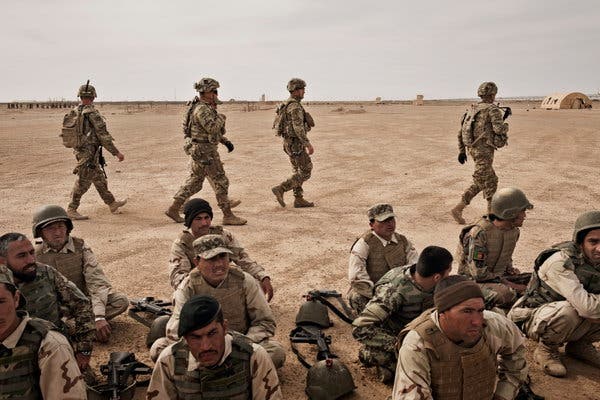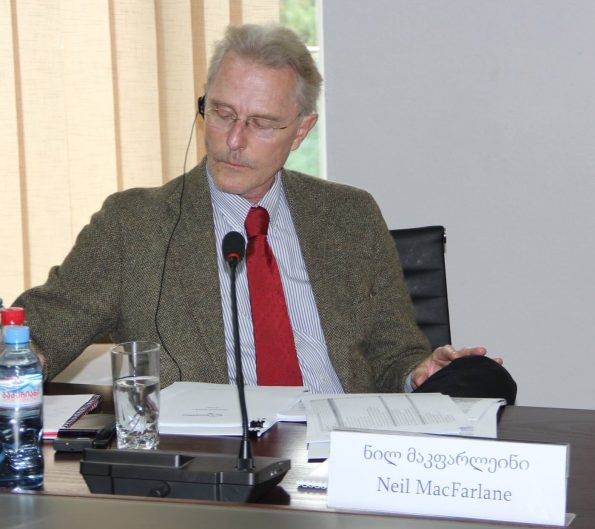
Dr Sharifullah Dorani*
Political Reflection Magazine | Vol. 20
This short essay contains two sections. Section one briefly reviews what the Groupthink Model is. Section two deals with how the approach can be applied to inform a foreign policy case by examining George W. Bush and Barack Obama’s decision making styles for Afghanistan and Iraq. The essay ends with some concluding remarks. The central aim of this paper is to demonstrate how the Groupthink Model can be utilised to explain and understand a foreign policy decision, as the author of this short essay has made extensive use of the model in his recently published book: America in Afghanistan.[1]
The Groupthink Model
In Foreign Policy Analysis (FPA) there have been approaches involving the effect of large and small group decision-making on foreign policy. Most decisions relating to foreign policy are made in small group settings, and one of the popular approaches has considered the effect of the dynamic of ‘small group of policy makers’ (about ten or more policymakers) upon foreign policy.
The Effect of Groupthink on the Afghanistan and Iraq Wars
One analysis of a number of small group decisions by Irving L. Janis, entitled Groupthink[2], discovered that there was always fear of exclusion and rejection by members of the group, and the primary purpose became to keep the group cohesive. As this occurred, there was the existence of ‘groupthink’, meaning the purpose of keeping the group cohesive replaced the purpose for which the group was built. Decisions were made, even though some members of the group did not agree but went ahead anyway for fear of exclusion. This had ‘dysfunctional consequences’ for the group process, which in turn had ramifications for foreign policy choices.[3] The ‘dysfunctional consequences’[4] of groupthink included: conformity or a sense of ‘we can easily’ achieve the objectives; discouraging an atmosphere of open debate between opposing camps/policymakers; disregarding warning signals from the rival groups and instead stereotyping their views; refusing to consult lower officials as well as experts; and failing to consider alternatives.
The effect of ‘groupthink’ – that is, especially a sense of ‘we can easily’ achieve the objectives of the Global War on Terror (GWOT) to root out terrorism by underestimating the enemy and chances of failure – was present during the decision making for the GWOT in September 2001: Bush and his advisors downplayed the shortcomings of ‘the counterterrorism strategy’ and exaggerated the usefulness of ‘the light footprint strategy’ (using a small number of American troops and resources); they did not discuss alternatives to the invasion of Afghanistan (and Iraq); they did not consider what to be done if things went wrong in Afghanistan and Iraq; they did not take dissent seriously from Secretary of State Colin Powell; they did no ascertain more precise information about the history, culture, society and traditions of Afghanistan (and Iraq) and its decades-long disputes with Pakistan.
Secretary of Defense Robert Gates, Steven Hurst and the Afghan expert Amin Saikal argue that being ignorant of Afghanistan and Iraq’s details was one major destructive factor, causing the United States (US) to announce objectives impossible to achieve. Learning in detail about the Af-Pak disputes, Bush might have requested concrete pledges from President of Pakistan, Pervez Musharraf, and, most importantly, kept a close watch on Pakistan’s double game post-Taliban defeat. Had Bush properly debated the way the Afghans perceived the warlords, he might have found alternatives to them, or at least developed a strategy to minimise their influence after the Taliban was defeated. Most importantly, Bush might have discovered alternatives to the decision to invade Afghanistan. In the end, an entirely different decision might have resulted. Instead of discussing the details regarding Afghanistan (and Iraq) as well as the wisdom of the GWOT, the discussion centred on developing a war plan, the issue of how wide terrorism was, and whether Iraq could be included at the first stage of the GWOT.[5] American journalist Rajiv Chandrasekaran wrote a bestseller on how unaware American policy makers were of the way of life in Iraq.[6]
But unlike Bush, Obama regarding the Afghanistan War used all the necessary methods to minimise the ‘dysfunctional consequences’ of groupthink: conformity or a sense of ‘we can easily’ achieve the objectives. Obama’s ‘rational’ approach required decisions to be made on the basis of ‘information’ not ‘emotions’. Obama preferred to have a deliberate and highly analytical process in which all contrasting views and options were analysed. The President, therefore, invited not only his immediate advisors to the decision making, but also career diplomats and experts (even from outside of the administration) to directly confront their policy suggestions, disagreements and, at times, themselves in front of the President.
Obama did not want to repeat the disorderly decision making process of President Lyndon Johnson in 1965 and Bush in 2002–3, in which both presidents failed to examine the reasoning, assess the consequences and debate the alternatives. It, therefore, took Obama three months to review all suggestions by the opposing camps to make his ‘surge decision’ in 2009. Furthermore, Obama’s analytical decision making style was one of the main reasons the review led to being debated in public.[7]
The Groupthink Model is a vital approach of FPA. It has been employed by foreign policy researchers to analyse foreign policy choices. This short essay has, likewise, explained in relation to the Bush and Obama Administrations’ decision making towards Afghanistan and Iraq that how a faulty operating style could lead to poor foreign policy decisions.
References
Allison GT and Zelikow P (1999) Essence of Decision: Explaining the Cuban Missile Crisis. New York: Longman.
Baker P (5 December 2009) How Obama Came to Plan for ‘Surge’ in Afghanistan. New York Times.
Chandrasekaran R (2006), Imperial Life in the Emerald City: Inside Baghdad’s Green Zone. New York: Alfred A. Knopf.
Clinton HR (2014) Hard Choices. New York: Simon & Schuster.
Desch MC (27 October 2009) ‘Obama and His General’, Foreign Affairs, http://www.foreignaffairs.com/articles/65662/michael-c-desch/obama-and-his-general.
Dobbins J (2007) Who Lost Iraq?, Foreign Affairs, http://www.foreignaffairs.com/articles/62828/james-dobbins/who-lost-iraq.
Dodge T and Redman N (2011). Afghanistan: To 2015 and Beyond. London: International Institute for Strategic Studies.
Dorani S (2019) America in Afghanistan: Foreign Policy and Decision Making from Bush to Obama to Trump. London: I.B. Tauris, Bloomsbury Publishing Plc.
Gates RM (2014) Duty: Memoirs of a Secretary at War. Alfred A. Knopf.
Hudson VM (2019) Foreign Policy Analysis: Classic and Contemporary Theory. Lanham, MD: Rowman & Littlefield Pub.
Hurst S (2009) The United States and Iraq Since 1979: Hegemony, Oil and War. Edinburgh: Edinburgh University Press.
Janis, IL (1982) Groupthink: Psychological Studies of Policy Decisions and Fiascoes. Boston: Houghton Mifflin.
Mann J (2012) The Obamians: The Struggle Inside the White House to Redefine American Power. New York: Viking.
Marshall JM (2003) Remaking the World: Bush and the Neoconservatives. Foreign Affairs, http://www.foreignaffairs.com/articles/59380/joshua-micah-marshall/remaking-the-world-bush-and-the-neoconservatives.
McGurk B (22 June 2011), ‘Agreeing on Afghanistan’, CNN, http://globalpublicsquare.blogs.cnn.com/2011/06/22/agreeing-on-afghanistan/.
Mullen MG (21 May “009) ‘Statement of Admiral Michael G. Mullen, US Chairman of the Joint Chiefs of Staff’, Senate Committee on Foreign Relations, https://www.foreign.senate.gov/imo/media/doc/MullenTestimony100518a.pdf.
Neack L, Hey J and Haney PJ (1995) Foreign Policy Analysis: Continuity and Change in its Second Generation. Englewood Cliffs, N.J.: Prentice Hall
Pfiffner JP (2008) Policymaking in the Bush White House. Brookings Institution, http://www.brookings.edu/research/papers/2008/10/31-bush-pfiffner.
—— (2011) Decision Making in the Obama White House. Presidential Studies Quarterly, 41: 2 (June).
Rashid A (2009) Descent into Chaos: The World’s Most Unstable Region and the Threat to Global Security. London: Penguin.
Saikal A (2014) Zone of Crisis: Afghanistan, Pakistan, Iran and Iraq. London: I.B. Tauris & Co.
Smith T, Hood L and Dobbins J (2007) Losing Iraq. Foreign Affairs, http://www.foreignaffairs.com/articles/63019/tony-smith-ludovic-hood-and-james-dobbins/losing-iraq.
Will GF (1 September 2009) Time to Get Out of Afghanistan. Washington Post.
Woodward B (2010) Obama’s Wars. New York: Simon & Schuster.
[1] Dorani S (2019) America in Afghanistan: Foreign Policy and Decision Making from Bush to Obama to Trump. London: I.B. Tauris, Bloomsbury Publishing Plc.
[2] Janis IL (1982) Groupthink: Psychological Studies of Policy Decisions and Fiascoes. Boston: Houghton Mifflin.
[3] Janis IL (1982), pp. 1–13.
[4] They (and the methods to avoid them) are found in Janis IL (1982), pp. 1–13; Neack L, Hey J and Haney PJ (1995) Foreign Policy Analysis: Continuity and Change in its Second Generation. Englewood Cliffs, N.J.: Prentice Hall, pp. 108–9; Hudson VM (2019) Foreign Policy Analysis: Classic and Contemporary Theory. Lanham, MD: Rowman & Littlefield Pub, pp. 72–3; Allison GT and Zelikow P (1999) Essence of Decision: Explaining the Cuban Missile Crisis. New York: Longman, p. 284.
[5] For the impact of groupthink in the Bush Administration, see Dorani S (2019), chapter five. See also, Pfiffner JP (2008) Policymaking in the Bush White House. Brookings Institution, http://www.brookings.edu/research/papers/2008/10/31-bush-pfiffner. —— (2011) Decision Making in the Obama White House. Presidential Studies Quarterly, 41: 2 (June); Dobbins J (2007) Who Lost Iraq? Foreign Affairs, http://www.foreignaffairs.com/articles/62828/james-dobbins/who-lost-iraq; Smith T, Hood L and Dobbins J (2007) Losing Iraq. Foreign Affairs, http://www.foreignaffairs.com/articles/63019/tony-smith-ludovic-hood-and-james-dobbins/losing-iraq; Rashid A (2009) Descent into Chaos: The World’s Most Unstable Region and the Threat to Global Security. London: Penguin, pp. XLI, XLII, XLVI–XLVII; Marshall JM (2003) Remaking the World: Bush and the Neoconservatives. Foreign Affairs, http://www.foreignaffairs.com/articles/59380/joshua-micah-marshall/remaking-the-world-bush-and-the-neoconservatives; Gates RM (2014) Duty: Memoirs of a Secretary at War. Alfred A. Knopf, pp. 49, 589; Clinton HR (2014) Hard Choices. New York: Simon & Schuster, p. 135; Saikal A (2014) Zone of Crisis: Afghanistan, Pakistan, Iran and Iraq. London: I.B. Tauris & Co, pp. 5–8, 15–59, 143–77; Hurst S (2009) The United States and Iraq Since 1979: Hegemony, Oil and War. Edinburgh: Edinburgh University Press, pp. 7, 182–223.
[6] Chandrasekaran R (2006), Imperial Life in the Emerald City: Inside Baghdad’s Green Zone. New York: Alfred A. Knopf.
[7] For the impact of groupthink in the Obama Administration, see Dorani S (2019), chapter seven. See also
Gates R (2014), pp. 289, 360, 367–70, 566, 585–6; Woodward B (2010) Obama’s Wars. New York: Simon & Schuster, pp. 157–9, 173–7, 197; Mann J (2012) The Obamians: The Struggle Inside the White House to Redefine American Power. New York: Viking, pp. xx, xix, 14–17, 135–6; Pfiffner JP (2011); Mullen MG (21 May “009) ‘Statement of Admiral Michael G. Mullen, US Chairman of the Joint Chiefs of Staff’, Senate Committee on Foreign Relations, https://www.foreign.senate.gov/imo/media/doc/MullenTestimony100518a.pdf; McGurk B (22 June 2011), ‘Agreeing on Afghanistan’, CNN, http://globalpublicsquare.blogs.cnn.com/2011/06/22/agreeing-on-afghanistan/; Desch MC (27 October 2009) ‘Obama and His General’, Foreign Affairs, http://www.foreignaffairs.com/articles/65662/michael-c-desch/obama-and-his-general; Dodge T and Redman N (2011). Afghanistan: To 2015 and Beyond. London: International Institute for Strategic Studies, p. 61; Baker P (5 December 2009) How Obama Came to Plan for ‘Surge’ in Afghanistan. New York Times; Will GF (1 September 2009) Time to Get Out of Afghanistan. Washington Post.
To Download the PDF, click here…



